In the early 20th century the Garden City town planning movement gained traction in Australia, with housing on spacious lots separated by manicured gardens. The suburb of Garden City in Port Melbourne is the best known local example, but there is a small pocket in the streets of Sunshine – the ‘Concrete Housing Estate’ on Leith Avenue, off Hampshire Road between Derby Road and Morris Street.
Let’s take a tour
The concrete houses on Leith Avenue are included on Heritage Overlay number HO020, and include twelve properties – eight houses at 1 to 15 Leith Avenue, and four houses at 51 – 57 Hampshire Road.
They are a short distance from the Sunshine grain silos.
A central reserve divides Leith Avenue.
The houses built to a common design.
Distinctive chimneys atop each one.
But each slightly different.
Four houses also front Hampshire Road.
Less notable than those on Leith Avenue.
But made of concrete all the same.
Six different house designs were used on the estate, with three of them surviving today.
Type 1 is block-fronted with a simple hipped roof. It has overhanging eaves at the centre of the facade, creating a window hood above the windows, resting on triangular timber brackets. Windows are paired six-over-one sashes in boxed (projecting) frames. These houses have decorative timber porches on the side elevation. Another distinctive feature of these houses is the narrow faceted cast-concrete chimneys.
Type 2 has a wide hipped-roof bay at the front with a recessed porch beneath it. The porch is lit by a windowlike opening on the facade. The windows of this type of house are set into moulded render surrounds.
There is one surviving house with a California Bungalow form (Type 3), on Hampshire Road. Its most distinctive feature is a half-timbered gable-roofed porch at the front. The porch is supported on three pairs of timber posts, which in turn rest on low rendered piers.
History of the estate
During the 1880s land boom, speculators carved up the land around the township then called ‘Braybrook Junction’.

From History of School 3113 Sunshine
But boom turned to bust, and the estate lay empty except for a handful of houses.
Enter industrialist H. V. McKay, and his Sunshine Harvester Works which moved to Braybrook Junction in 1906. Driven by either generosity or paternalism, McKay developed housing estates across Sunshine for his workers, the largest of which is now the suburb of Albion.
But a smaller estate of twenty-six homes was built on Leith Avenue – nine either side of the central park, and two groups of four facing Hampshire Road.

1945 Department of Lands and Survey photo map
Set on a court constructed with concrete road, kerb and channel around an oblong central grassed median, construction commenced in 1924, financed by the State Savings Bank of Victoria, and designed by their chief architect Burridge Leith.
Concrete Cottages
Two Dozen for SunshineA scheme has recently been approved of by the State Savings Bank in regard to the building of concrete dwelling houses by a system of organisation, which will make the cost very little in excess of wood. The first of the cottages built in the State by this new system was erected in Brighton, and has proved a success, and arrangements have been made to erect about 26 such residences in Hampshire Road, Sunshine, for employees of the Harvester Works. The building of the houses is being financed by the State Savings Bank. The cost of the buildings will vary from about £650 to £800, and the bank accepts a 10 per cent deposit of the capital cost of land and building, the remainder, of course, being payable in weekly contributions over a term of years.
The use of concrete sped up the construction process.
House Built in a Day
Moulded Concrete EmployedTwenty-five houses are being built of “poured” concrete at Sunshine (Vic.) Some have been erected, the last establishing what is claimed as a world record for speedy construction; all the moulds were set and all the walls, interior and exterior “poured” and reinforced with steel in 28 hours.
This extremely rapid work, of course, means an immense saving in labour, costs, as the weekly bill for wages almost disappears. That a building produced in such an infinitesimal space of time can be practically everlasting seems to upset all previous notions of the value of slow and careful workmanship.
But in this case swift work means good work, as the rapid pouring of the concrete means that the whole of the walls will set together in one monolithic mass. This could not be achieved if the house were built up slowly in layers, causing joins in the walls and liability to cracking.
During the latter part of the winter a plant was constructed at Sunshine to conform to the new plans of the Monolyte houses designed by the chief architect of tho State Savings Bank and a start was made with the work, in connection with an extensive building contract on behalf of and under the supervision of the State Savings Bank. Houses are now being rapidly “poured” one after the other. The
usual time occupied by this system for the purpose of erecting the forms and work incidental thereto, including reinforcing, etc., is roughly five to six days, according to the size of the house to be built, while the pouring of the walls takes another six hours, thus making tho house ready for roofing within seven days.On Monday of one week a start was made with a house of the series, and so well did tho team perform its work that tho whole of the forms were set up and the special steel reinforcing placed in position by Wednesday, thus occupying barely three days for this preliminary work. Pouring operations under the supervision of the inventor, Mr, S. B. Merchant, were commenced afterwards, and completed within four hours and ten minutes altogether, a most remarkably speedy and effective performance.
Thus with only 28 hours work (three and a half days) the whole walls, fireplaces and chimneys of a perfectly-constructed and reinforced house were completed, and the carpenters are soon busily proceeding with the erection of the roof. The moulds were again removed and re-erected ready for refilling with an other house, thus taking five days to strip from one job and rebuild another site requiring five hours or less to complete the second house within six days, and without any addition to the constant team employed on the works.
And was cheaper than timber.
Quick Concrete Houses
Sunshine is to be the scene of further pioneer work with poured concrete houses. A contract has been let by the Sunshine Harvester Company for the erection of a number of these structures in the harvester city.
Already one poured concrete house erected at Brighton has proved its stability as a liveable dwelling. The walls and roof were constructed in a week, and the Melbourne Savings Bank Commissioners, who viewed the work in progress were very favourably impressed by the achievement.
The houses now to be constructed at Sunshine will also he watched by the Savings Bank officials, who see in the system a possible means of rapid construction of artisans’ homes of a more durable quality than the timber houses now in favour. It is hoped that by rapid construction concrete houses can be turned out in large quantities at very little more than the present cost of wood construction and considerably cheaper than brick.
A concrete building completed within a fortnight is a distinctly advantageous asset over brick or timber dwelling that takes three to five months to construct. Every week gain means money in the owner’s pocket, as it saves interest and rent. The concrete dwelling also saves money every year in the matter of maintenance, as it does not require painting or structural repairs. This point appeals strongly to the Savings Bank Commissioners, who are mindful of the fact that they carry mortgages over many thousands of timber houses for periods of twenty-one years, and that those are all to some extent “wasting assets”.
At Sunshine cement and sand are available for concrete construction, but in the past the houses there were built of timber. Once the value of the concrete house is proved it is likely that Sunshine will gradually develop into a concrete city.
With the estate completed by 1926.
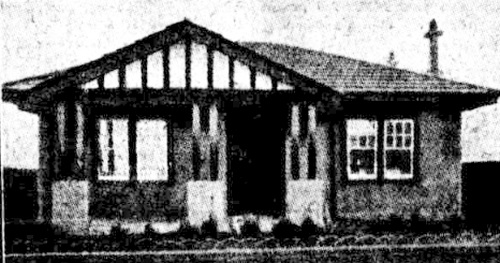
The Daily Mail Brisbane, 3 January 1926
A decade later in 1935, the estate was considered a stand out in the area.
Provision by the shire council of concrete footpaths in most of the streets of Sunshine should be an incentive for householders to keep in proper condition the narrow strip of space between the concrete and the kerb. Appeals have from time to time been made by council officers in the columns of the “Advocate,” but these have only been partially heeded.
A journey through the locality past the school fails to create much enthusiasm. One thoroughfare – Leith Avenue – presents a row of neat dwellings and footpaths well tended,:but further down Hampshire Road things are not so good except for one or two isolated places which show up to distinct advantage.
But a decade later it was looking a little worse for wear.
A sub-committee of the Braybrook Council is to consider if anything can be done to place the reserves in Leith Avenue, Sunshine, in order. Cr. Drayton, the mover of the motion, said that the condition of these reserves had been a bone of contention for years.
But where did the other half go?
As originally built, there were houses on both sides of Leith Avenue.

1945 Department of Lands and Survey photo map
Visible in the 1966 edition 1 Melway.
But today the entire north side is part of the neighbouring Sunshine Primary School and Sunshine Secondary College.
Some of the blocks still exist on their own land title.
And on the ground, the remains of driveways can be seen along Leith Avenue.
The reason? A Public Acquisition Overlay covers the land – PAO6 on the Brimbank Planning Scheme – favouring the Department of Education, for an ‘education centre’.

Brimbank Planning Scheme – map 12PAO
The adjoining Sunshine School 3113 was established in 1891, with the current brick building officially opened in 1931.
In 1913 the Sunshine Technical School opened next door, followed in 1938 by the Sunshine Girls Technical School, and expanded in 1941.
And the houses on the north side of Leith Avenue?

Charles Daniel Photograph, SLV H2016.33/102
They were progressively acquired by the State Government, including:
- 10 Leith Avenue in March 1975 for $9,750,
- 6 Leith Avenue in July 1976 for $28,000, and
- 59 Hampshire Road in August 1981 for $40,000.
And a Graham Street footnote
Remember Graham Street South? Turns out the block bounded by Graham Street and Derby Road was once covered by houses, but a Public Acquisition Overlay has seen it replaced by empty land.

Charles Daniel Photograph, SLV H2016.33/102
Properties acquired include:
- 137 Derby Road in July 1975 for $22,500,
- 139 Derby Road in February 1976 for $25,000,
- 141 Derby Road in March 1976 for $27,000,
- 143 Derby Road in September 1976 for $27,000,
- 63 Graham Street in August 1984 for $35,000, and
- 67 Graham Street in September 1976 for $29,000.
But this empty land will never see a school built on it – plans to build a new school were launched in 2006 but it was shelved in 2010. Finally in 2015 it was announced that Sunshine College would be upgraded at a cost of $10 million, but consolidated onto the West and North campuses, with the Ardeer and Senior campuses closed.
Sources
- Brimbank Heritage Design Guidelines: HO20 – Concrete Housing Estate, Sunshine
- Victorian Heritage Database: Concrete Housing Estate Precinct
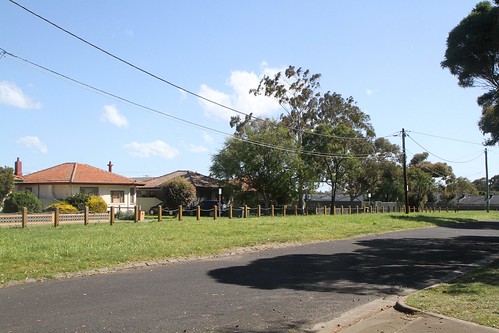
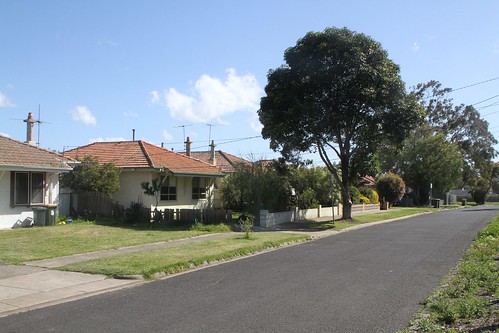
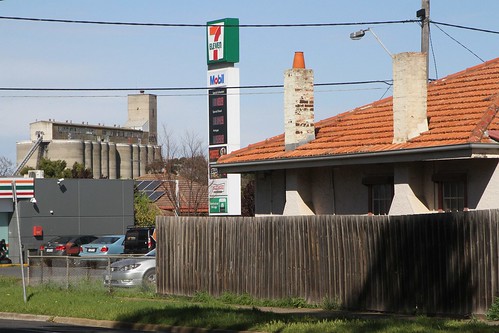


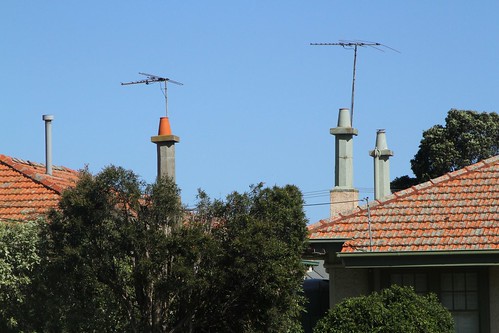








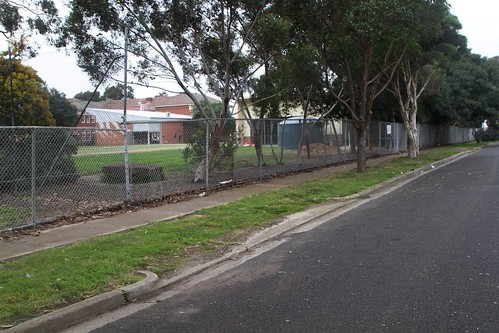
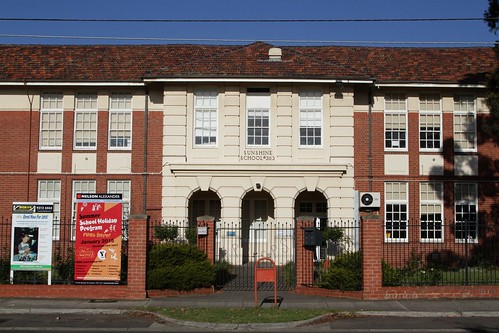

Marcus,
I have discovered some more empty blocks on the west side of Anderson Rd, Sunshine. The numbers are 27 through 45. These blocks would back onto Kororoit Creek.
Around the corner Thyra Street also has some empty blocks – again due to the creek.